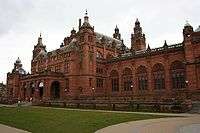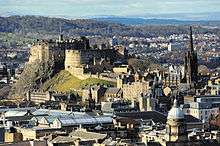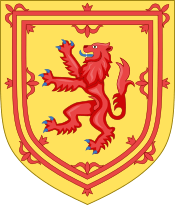Tourism in Scotland
Scotland is a well-developed tourist destination, with tourism generally being responsible for sustaining 200,000 jobs mainly in the service sector, with tourist spending averaging at £4bn per year.[1] In 2013, for example, UK visitors made 18.5 million visits to Scotland, staying 64.5 million nights and spending £3.7bn. In contrast, overseas residents made 1.58 million visits to Scotland, staying 15 million nights and spending £806m. In terms of overseas visitors, those from the United States made up 24% of visits to Scotland, with the United States being the largest source of overseas visitors, and Germany (9%), France (8%), Canada (7%) and Australia (6%), following behind.[2]


Scotland is generally seen as a destination with beautiful scenery combined with thousands of historic sites and attractions.[3] These include prehistoric stone circles, standing stones and burial chambers, and various Bronze Age, Iron Age and Stone Age remains. There are also many historic castles, houses, and battlegrounds, ruins and museums. Many people are drawn by the culture of Scotland.
The main tourist season is generally from April to October. In addition to these factors, the national tourist agency, VisitScotland, have deployed a strategy of niche marketing, aimed at exploiting, amongst other things, Scotland's strengths in golf, fishing and food and drink tourism.
Statistics
Most visitors (for any purpose) to Scotland in 2018 came from the following countries:[4]
| Rank | Country | Number |
|---|---|---|
| 1 | United States | 492,000 |
| 2 | Germany | 451,000 |
| 3 | France | 318,000 |
| 4 | Italy | 268,000 |
| 5 | Spain | 205,000 |
| 6 | Australia | 172,000 |
| 7 | Netherlands | 172,000 |
| 8 | Canada | 131,000 |
| 9 | Sweden | 121,000 |
| 10 | Norway | 106,000 |
| Rest of the World | 1,102,000 | |
| Total overseas tourist visits | 3,538,000 |
Tourist destinations
- Edinburgh is the capital city. The Old and New Towns of the city constitute a UNESCO World Heritage Site. Edinburgh is the largest tourist destination in Scotland, and the second largest in the United Kingdom after London. The cities' major tourist attractions include Edinburgh Castle, Edinburgh Zoo, the Palace of Holyroodhouse, Our Dynamic Earth and the Royal Mile. It has four universities including the University of Edinburgh founded in 1583.
- Glasgow is the largest city in the country, and the second largest tourist destination after Edinburgh. Its attractions include the Burrell Collection, Glasgow Cathedral, the Glasgow Science Centre and the Kelvingrove Museum. In addition to this many tourists come to Glasgow for its renowned Victorian architecture and Gothic architecture as well as its shopping. The city has three universities, including the University of Glasgow founded in 1451, and is a UNESCO City of Music which hosts the world renowned Royal Conservatoire of Scotland and Royal Scottish National Orchestra.
- Stirling is a historic city in central Scotland, some 30 miles to the north-west of Edinburgh, and is generally known as the "Gateway to the Highlands", due to its geographical position between highland and lowland Scotland. Amongst its attractions are Stirling Castle, the Wallace National Monument and the Thieves Pot/Thistles Centre.
- Aberdeen is known as the "Granite City" and is renowned for its gothic architecture. It is a city of approximately 210,000 people and serves as the main administrative centre for the north-east of Scotland. With its large port and harbour, Aberdeen serves as the departure point for the many ferries that connect the Scottish mainland with the Northern Isles of Orkney and Shetland. Aberdeen also has two universities, and a large student population.
- St Andrews is a small, but busy town in north-east Fife. The royal burgh's economy is centred on the golf industry, with St Andrews being regarded as the home of the modern game. The University of St Andrews (the oldest in Scotland) has colleges located throughout the town and a small museum on the history of the University which is open to the public free of charge.
- Dundee is known as the "City of Discovery" and is the home of V&A Dundee, Scotland's first and only design museum. Dundee is also home to Scott of the Antarctic's ship the RRS Discovery. Dundee has two universities. It has a Jute museum called Verdant Works, an Anchor Point of ERIH – The European Route of Industrial Heritage.
- Perth is a small but historic city on the east coast, which stands on the River Tay. Perth is known for its abundant parkland. Close by is the village of Scone, ancient capital of Scotland and former home to Scottish kings.
- Inverness is the administrative centre for the Highlands, close to Loch Ness and serves as a transport hub for much of the Highlands, with rail and bus services departing here to much of the northern and west Highlands. It is a popular destination for tourists wishing to explore the north of Scotland.
- Ayrshire offers wonderful scenery, outdoor activities, enthralling history with links to William Wallace, Robert the Bruce and Scotland's best known poet, Robert Burns. Ayrshire also offers some of the finest golf courses in the world (32 in total). North Ayrshire hosts Kelburn Castle which is famous for its Graffiti Project.
Other areas which are popular for tourists include the Highlands and the Hebrides, such as the Isle of Skye. Perthshire, the Scottish Borders and Orkney and Shetland are also popular tourism destinations.
Ben Nevis is the highest mountain in the United Kingdom, but there are many other significant mountains in Scotland. However, by international standards, all the mountains are relatively small. The Cuillin on the Isle of Skye offer some challenging climbs, such as the Inaccessible Pinnacle.
Scotland also has some amusement parks. One such park is M&D's in the town of Motherwell, North Lanarkshire.

Scotland also has many lochs, including Loch Lomond, and Loch Ness, which is considered by some to be the home of the Loch Ness monster. There are also many rivers, which are good for salmon and fly fishing. These include the Tay, Tweed, Don, and Dee.
Scotland's best known export is Scotch Whisky and numerous visitors a year enjoy a tour around its Whisky distilleries. The Highlands is by far the largest region in Scotland both in area and in whisky production. This massive area has over 30 distilleries on the mainland. When the Islands sub-region is included, the total number of distilleries is 47. [5] The nearby Speyside area has the largest number of distilleries of any district in the country, which includes: Aberlour, Balvenie, Cardhu, Cragganmore, Dalwhinnie,[6] Glenfarclas, Glenglassaugh, Glenfiddich, Speyburn, The Macallan, The Glenlivet, and The Glenrothes.[7][8] Distilleries are the third most visited attractions in Scotland; roughly 2 million visits were recorded in 2018. Some 68 distilleries operate visitors' centres in Scotland and another eight accept visits by appointment. Hotels, restaurants and other facilities are also impacted by the tourism phenomenon. The tourism has had an especially visible impact on the economy in some remote rural areas.[9][10]
Scotland is a popular destination for hunting, especially deer and grouse.
Scotland is also the home of golf, with many historic and famous courses including, St Andrews, Gleneagles, Royal Troon, Carnoustie, and Muirfield. There are hundreds of other courses in the country.
 Kelvingrove Art Gallery and Museum, the third most visited museum in Scotland
Kelvingrove Art Gallery and Museum, the third most visited museum in Scotland Edinburgh Castle dominates the city skyline
Edinburgh Castle dominates the city skyline The world-famous Loch Ness
The world-famous Loch Ness The Forth Road Bridge and Forth Bridge
The Forth Road Bridge and Forth Bridge The ruins of Melrose Abbey, Scottish Borders
The ruins of Melrose Abbey, Scottish Borders A Scottish Great Highland Bagpipe player, a symbol of Scotland's heritage, playing in front of Bidean nam Bian on the southern side of Glen Coe.
A Scottish Great Highland Bagpipe player, a symbol of Scotland's heritage, playing in front of Bidean nam Bian on the southern side of Glen Coe.
See also
- Golf in Scotland
- VisitScotland
- Museums in Scotland
- Scotch whisky
- Scottish topics
- Common Travel Area
- Tourism in England
- Tourism in Wales
- Wild Scotland
- Most visited museums in the United Kingdom
References
- "Tourism". The Scottish Government.
- "Visit Britain: Insights and Statistics". Archived from the original on 2005-12-03.
- "Scotland | ALBA". VisitScotland.
- https://www.visitscotland.org/binaries/content/assets/dot-org/pdf/research-papers-2/key-facts-on-tourism-in-scotland-2018-v2.pdf
- "TWHISKY DISTILLERIES IN THE HIGHLANDS". Visit Scotland. 11 July 2017. Retrieved 12 January 2020.
- Scotch Whisky Association 2009.
- "Speyside Distilleries – Whisky Tours, Tastings & Map". VisitScotland.
- "Breweries/Distilleries". Visit Cairngorns. 11 July 2017. Retrieved 8 December 2019.
- "Record numbers of visitors for Scotch Whisky Distilleries". 21 June 2019.
- Scotch Whisky Tourism at All-Time High
External links
| Wikivoyage has a travel guide for Scotland. |
